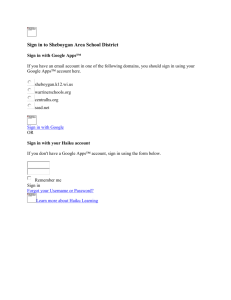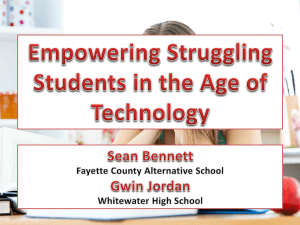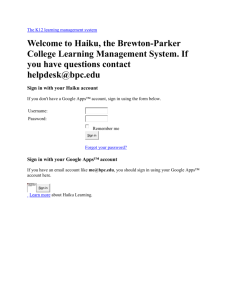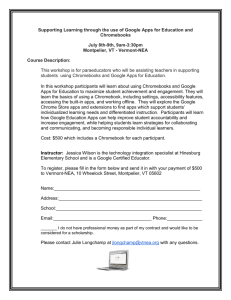20110703sp
advertisement
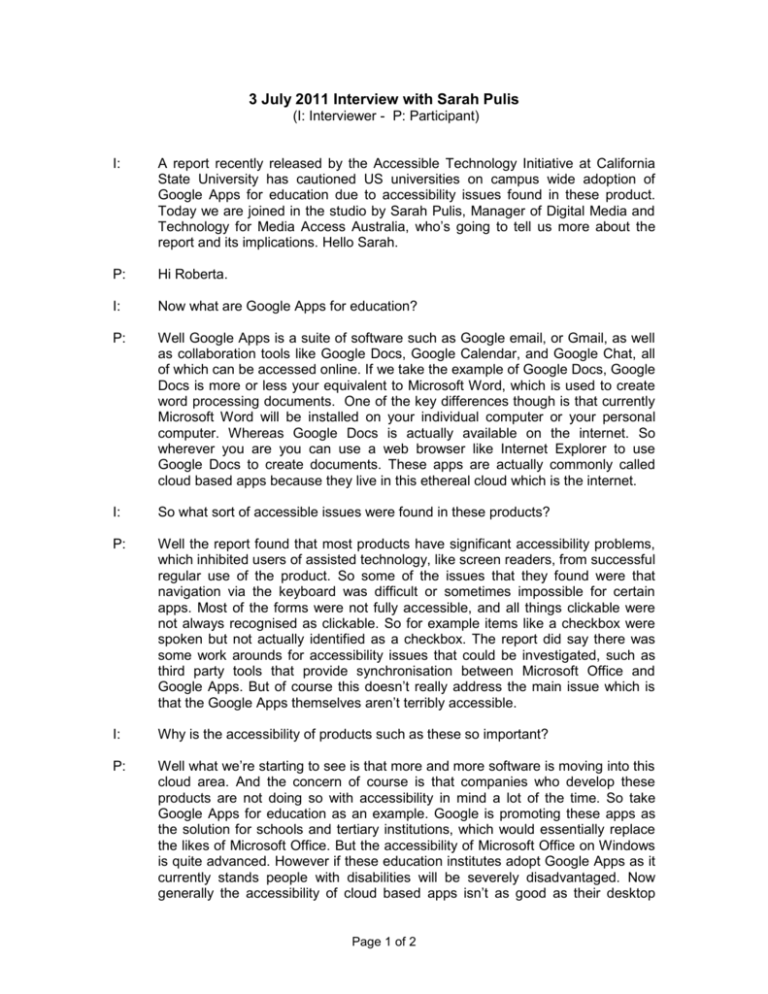
3 July 2011 Interview with Sarah Pulis (I: Interviewer - P: Participant) I: A report recently released by the Accessible Technology Initiative at California State University has cautioned US universities on campus wide adoption of Google Apps for education due to accessibility issues found in these product. Today we are joined in the studio by Sarah Pulis, Manager of Digital Media and Technology for Media Access Australia, who’s going to tell us more about the report and its implications. Hello Sarah. P: Hi Roberta. I: Now what are Google Apps for education? P: Well Google Apps is a suite of software such as Google email, or Gmail, as well as collaboration tools like Google Docs, Google Calendar, and Google Chat, all of which can be accessed online. If we take the example of Google Docs, Google Docs is more or less your equivalent to Microsoft Word, which is used to create word processing documents. One of the key differences though is that currently Microsoft Word will be installed on your individual computer or your personal computer. Whereas Google Docs is actually available on the internet. So wherever you are you can use a web browser like Internet Explorer to use Google Docs to create documents. These apps are actually commonly called cloud based apps because they live in this ethereal cloud which is the internet. I: So what sort of accessible issues were found in these products? P: Well the report found that most products have significant accessibility problems, which inhibited users of assisted technology, like screen readers, from successful regular use of the product. So some of the issues that they found were that navigation via the keyboard was difficult or sometimes impossible for certain apps. Most of the forms were not fully accessible, and all things clickable were not always recognised as clickable. So for example items like a checkbox were spoken but not actually identified as a checkbox. The report did say there was some work arounds for accessibility issues that could be investigated, such as third party tools that provide synchronisation between Microsoft Office and Google Apps. But of course this doesn’t really address the main issue which is that the Google Apps themselves aren’t terribly accessible. I: Why is the accessibility of products such as these so important? P: Well what we’re starting to see is that more and more software is moving into this cloud area. And the concern of course is that companies who develop these products are not doing so with accessibility in mind a lot of the time. So take Google Apps for education as an example. Google is promoting these apps as the solution for schools and tertiary institutions, which would essentially replace the likes of Microsoft Office. But the accessibility of Microsoft Office on Windows is quite advanced. However if these education institutes adopt Google Apps as it currently stands people with disabilities will be severely disadvantaged. Now generally the accessibility of cloud based apps isn’t as good as their desktop Page 1 of 2 equivalent. And when we see the likes of Google openly acknowledging that, for instance, between 40% and 50% of the Accessibility Guidelines are not fully supported in Google Apps, then it really is a real worry. I: What were the recommendations for the adoption of these apps? P: The report actually broke it up into three separate recommendations. The first one was that there be limited adoption or use of Google forms, site and Gmail chat for all users. So these were the ones that came up as I guess having the worst accessibility. That apps like Google Docs, spreadsheet, presentation and calendar be used by administrative staff only and that there be limited use of Google Docs, spreadsheet, presentation, forms, et cetera, just for the student base. So all in all they sort of broke it up into three tiers. But overall the apps still weren’t wholly accessible. I: Is this going to happen though? P: Well look in the US because of the way their policy is set up I doubt that any university will actually adopt Google Apps because they’ll really leave themselves open to litigation. But of course these apps are currently available, things like Gmail and Google Docs, are available to all people, and so that essentially means that the average user cannot actually use these apps. So it’s really a problem. I: It certainly is. Well for more information on access to digital technology and online media for the blind and vision impaired, visit the Media Access Australia website, www, of course, mediaaccess.org.au or phone 02 9212 6242. Thank you Sarah. P: No problem, Roberta. I: I’ve been speaking with Sarah Pulis, Manager of Digital Media and Technology from Media Access Australia. And Media Access Australia are supporters of this program. Page 2 of 2


